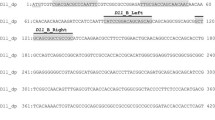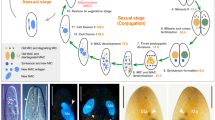Abstract
How morphological diversity arises is a key question in evolutionary developmental biology. As a long-term approach to address this question, we are developing the water bear Hypsibius dujardini (Phylum Tardigrada) as a model system. We expect that using a close relative of two well-studied models, Drosophila (Phylum Arthropoda) and Caenorhabditis elegans (Phylum Nematoda), will facilitate identifying genetic pathways relevant to understanding the evolution of development. Tardigrades are also valuable research subjects for investigating how organisms and biological materials can survive extreme conditions. Methods to disrupt gene activity are essential to each of these efforts, but no such method yet exists for the Phylum Tardigrada. We developed a protocol to disrupt tardigrade gene functions by double-stranded RNA-mediated RNA interference (RNAi). We showed that targeting tardigrade homologs of essential developmental genes by RNAi produced embryonic lethality, whereas targeting green fluorescent protein did not. Disruption of gene functions appears to be relatively specific by two criteria: targeting distinct genes resulted in distinct phenotypes that were consistent with predicted gene functions and by RT-PCR, RNAi reduced the level of a target mRNA and not a control mRNA. These studies represent the first evidence that gene functions can be disrupted by RNAi in the phylum Tardigrada. Our results form a platform for dissecting tardigrade gene functions for understanding the evolution of developmental mechanisms and survival in extreme environments.




Similar content being viewed by others
References
Aguinaldo AM, Turbeville JM, Linford LS, Rivera MC, Garey JR, Raff RA, Lake JA (1997) Evidence for a clade of nematodes, arthropods and other moulting animals. Nature 387:489–493
Ahringer J (ed) (2006) Reverse genetics. In: WormBook. The C. elegans research community (ed). doi: /10.1895/wormbook.1.47.1
Ammermann D (1967) Die Cytologie der Parthenogenese bei dem Tardigraden Hypsibius dujardini. Chromosoma 23:203–213
Benton R, Palacios IM, St Johnston D (2002) Drosophila 14-3-3/PAR-5 is an essential mediator of PAR-1 function in axis formation. Dev Cell 3:659–671
Bertolani R (1983) Tardigrades. In: Reproductive biology of invertebrates, vol I. Wiley, Chichester, pp 431–441
Bosher JM, Labouesse M (2000) RNA interference: genetic wand and genetic watchdog. Nature Cell Biol 2:E31–E36
Boswell RE, Prout ME, Steichen JC (1991) Mutations in a newly identified Drosophila melanogaster gene, mago nashi, disrupt germ cell formation and result in the formation of mirror-image symmetrical double abdomen embryos. Development 113:373–384
Campbell LI, Rota-Stabelli O, Edgecombe GD, Marchioro T, Longhorn SJ, Telford MJ, Philippe H, Rebecchi L, Peterson KJ, Pisani D (2011) MicroRNAs and phylogenomics resolve the relationship of Tardigrada and suggest that velvet worms are the sister group of Arthropoda. Proc Natl Acad Sci USA 108:15920–15924
Cerutti H, Casas-Mollano JA (2006) On the origin and functions of RNA-mediated silencing: from protists to man. Curr Genet 50:81–99
Dorsett M, Schedl T (2009) A role for dynein in the inhibition of germ cell proliferation fate. Mol Cell Biol 29:6128–6139
Dunn CW, Hejnol A, Matus DQ, Pang K, Browne WE, Smith SA, Seaver E, Rouse GW, Obst M, Edgecombe GD, Sørensen MV, Haddock SHD, Schmidt-Rhaesa A, Okusu A, Kristensen RM, Wheeler WC, Martindale MQ, Giribet G (2008) Broad phylogenomic sampling improves resolution of the animal tree of life. Nature 452:745–749
Epstein HF, Waterston RH, Brenner S (1974) A mutant affecting the heavy chain of myosin in Caenorhabditis elegans. J Mol Biol 90:291–300
Fire A, Xu S, Montgomery MK, Kostas SA, Driver SE, Mello CC (1998) Potent and specific genetic interference by double-stranded RNA in Caenorhabditis elegans. Nature 391(6669):806–811
Gabriel WN, Goldstein B (2007) Segmental expression of Pax3/7 and engrailed homologs in tardigrade development. Dev Genes Evol 217:421–433
Gabriel WN, McNuff R, Patel SK, Gregory TR, Jeck WR, Jones CD, Goldstein B (2007) The tardigrade Hypsibius dujardini, a new model for studying the evolution of development. Dev Biol 312:545–559
Giribet G, Edgecombe GD (2012) Reevaluating the Arthropod tree of life. Annu Rev Entomol 57:167–186
Guidetti R, Altiero T, Rebecchi L (2011) On dormancy strategies in tardigrades. J Insect Physiol 57:567–576
Hannon GJ (2002) RNA interference. Nature 418:244–251
Hejnol A, Obst M, Stamatakis A, Ott M, Rouse GW, Edgecombe GD, Martinez P, Baguna J, Bailly X, Jondelius U, Wiens M, Müller WEG, Seaver E, Wheeler WC, Martindale MQ, Giribet G, Dunn CW (2009) Assessing the root of bilaterian animals with scalable phylogenomic methods. Proc R Soc Lond B Biol Sci 276:4261–4270
Janssen R, Eriksson BJ, Budd GE, Akam M, Prpic N-M (2010) Gene expression patterns in an onychophoran reveal that regionalization predates limb segmentation in pan-arthropods. Evol Dev 12:363–372
Jönsson KI (2007) Tardigrades as a potential model organism in space research. Astrobiology 7:757–766
Jönsson KI, Rabbow E, Schill RO, Harms-Ringdahl M, Rettberg P (2008) Tardigrades survive exposure to space in low Earth orbit. Curr Biol 18:R729–R731
Karki S, Holzbaur EL (1999) Cytoplasmic dynein and dynactin in cell division and intracellular transport. Curr Opin Cell Biol 11:45–53
Li W, Boswell R, Wood WB (2000) mag-1, a homolog of Drosophila mago nashi, regulates hermaphrodite germ-line sex determination in Caenorhabditis elegans. Dev Biol 218:172–182
Micklem DR, Dasgupta R, Elliott H, Gergely F, Davidson C, Brand A, González-Reyes A, St Johnston D (1997) The mago nashi gene is required for the polarisation of the oocyte and the formation of perpendicular axes in Drosophila. Curr Biol 7:468–478
Morton DG, Shakes DC, Nugent S, Dichoso D, Wang W, Golden A, Kemphues KJ (2002) The Caenorhabditis elegans par-5 gene encodes a 14-3-3 protein required for cellular asymmetry in the early embryo. Dev Biol 241:47–58
Møbjerg N, Halberg KA, Jørgensen A, Persson D, Bjørn M, Ramløv H, Kristensen RM (2011) Survival in extreme environments—on the current knowledge of adaptations in tardigrades. Acta Physiol 202:409–420
Newmark PA, Boswell RE (1994) The mago nashi locus encodes an essential product required for germ plasm assembly in Drosophila. Development 120:1303–1313
Newmark PA, Mohr SE, Gong L, Boswell RE (1997) mago nashi mediates the posterior follicle cell-to-oocyte signal to organize axis formation in Drosophila. Development 124:3197–3207
Parma DH, Bennett PE Jr, Boswell RE (2007) Mago Nashi and Tsunagi/Y14, respectively, regulate Drosophila germline stem cell differentiation and oocyte specification. Dev Biol 308:507–519
Pollard TD, Cooper JA (2009) Actin, a central player in cell shape and movement. Science 326:1208–1212
Ramazzotti G, Maucci W (1983) Il Phylum Tardigrada (The Phylum Tardigrada) (trans: Beasley CW), vol 41. Memoire dell'Istituto Italiano di Idrobiologia Dott. Marco de Marchi, Third Edition edn. Istituto Italiano di Idrobiologia, Verbania Pallanza
Rebecchi L, Altiero T, Guidetti R, Cesari M, Bertolani R, Negroni M, Rizzo AM (2009) Tardigrade resistance to space effects: first results of experiments on the LIFE-TARSE mission on FOTON-M3 (September 2007). Astrobiology 9:581–591
Rebecchi L, Bertolani R (1994) Maturative pattern of ovary and testis in eutardigrades of freshwater and terrestrial habitats. Invert Reprod Dev 26:107–118
Regulski M, McGinnis N, Chadwick R, McGinnis W (1987) Developmental and molecular analysis of Deformed; a homeotic gene controlling Drosophila head development. EMBO J 6:767–777
Robertson SM, Shetty P, Lin R (2004) Identification of lineage-specific zygotic transcripts in early Caenorhabditis elegans embryos. Dev Biol 276:493–507
Rota-Stabelli O, Kayal E, Gleeson D, Daub J, Boore JL, Telford MJ, Pisani D, Blaxter M, Lavrov DV (2010) Ecdysozoan mitogenomics: evidence for a common origin of the legged invertebrates, the Panarthropoda. Genome Biol Evol 2:425–440
Simpson P (2002) Evolution of development in closely related species of flies and worms. Nature Rev Genet 3:1–11
Stark GR, Kerr IM, Williams BR, Silverman RH, Schreiber RD (1998) How cells respond to interferons. Annu Rev Biochem 67:227–264
Strome S, Powers J, Dunn M, Reese K, Malone CJ, White J, Seydoux G, Saxton W (2001) Spindle dynamics and the role of gamma-tubulin in early Caenorhabditis elegans embryos. Mol Biol Cell 12:1751–1764
Telford MJ, Bourlat SJ, Economou A, Papillon D, Rota-Stabelli O (2008) The evolution of the Ecdysozoa. Philos Trans R Soc Lond B Biol Sci 363:1529–1537
Thompson JD, Higgins DG, Gibson TJ (1994) CLUSTAL W: improving the sensitivity of progressive multiple sequence alignment through sequence weighting, position-specific gap penalties and weight matrix choice. Nucleic Acids Res 22:4673–4680
Tuschl T (2001) RNA interference and small interfering RNAs. ChemBioChem 2:239–245
Wełnicz W, Grohme MA, Kaczmarke Ł, Schill RO (2011) Anhydrobiosis in tardigrades—the last decade. J Insect Physiol 57:577–583
Wiens M, Belikov SI, Kaluzhnaya OV, Krasko A, Schröder HC, Perovic-Ottstadt S, Müller WEG (2006) Molecular control of serial module formation along the apical–basal axis in the spong Lubomirskia baicalensis: silicateins, mannose-binding lectin and mago nashi. Dev Genes Evol 216:229–242
Wright JC (1989) Desiccation tolerance and water-retentive mechanisms in tardigrades. J Exp Biol 142:267–292
Wright JC (2001) Cryptobiosis 300 years on from van Leuwenhoek: what have we learned about tardigrades? Zool Anz 240:563–582
Acknowledgments
We thank Bob McNuff for the continuing help with tardigrade cultures, Victoria Madden for helping with electron microscopy, and members of the Goldstein lab for the critical reading of this manuscript. J.R.T. was supported by the National Institutes of Health, Minority Opportunities in Research division of the National Institute of General Medical Sciences (NIGMS) grant K12GM000678 and by the NIH-funded UNC Developmental Biology Training Grant (T32HD046369-03). S.M. was supported by ARRA funding from the Minority Opportunities in Research (MORE) division of the National Institute of General Medical Sciences (NIGMS) supplementing the IRACDA/SPIRE grant K12GM000678. This work was supported by NSF grants IOS 0235658 and IOS 0652007 to B.G.
Author information
Authors and Affiliations
Corresponding author
Additional information
Communicated by: Dahua Chen
Electronic supplementary material
Rights and permissions
About this article
Cite this article
Tenlen, J.R., McCaskill, S. & Goldstein, B. RNA interference can be used to disrupt gene function in tardigrades. Dev Genes Evol 223, 171–181 (2013). https://doi.org/10.1007/s00427-012-0432-6
Received:
Accepted:
Published:
Issue Date:
DOI: https://doi.org/10.1007/s00427-012-0432-6




